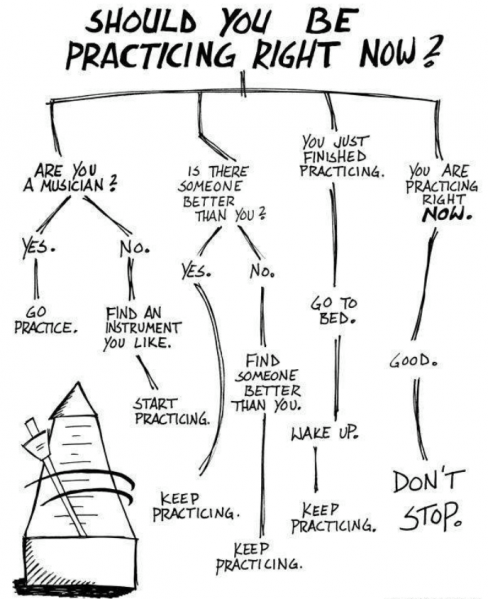Practicing the Correct Way
Live Lessons EP003 – Master Practicing

Practice… ugh
Everyone knows practicing is the best way to improve, but why does it feel so unexciting? The reason is simple, you may be practicing the wrong way. I know I did, until I enrolled in music college and erased years of bad practicing etiquette. Curious what our first lesson was in music college? Here’s a hint: You’re reading about it right now. That’s how important proper practice is.
The 3 Steps for Proper Practice
- Repetition
- Reinforcement
- Evaluation
Repetition
This may seem obvious, but let’s look at the details.
When you are learning a piece of music, break it down into smaller sections. Don’t try to play everything at once. A good rule of thumb is to go bar-by-bar. You should aim to master the bar or phrase before moving onto the next one. This does not mean you have to play it up to speed, but you should be able to repeat (loop) the phrase 5 times in a row playing each note/chord in time and with clarity.
Reinforcement
This is the act of coming back to the music we have practiced and doing it again after some time has passed.
There is only so much repetition one can do in a day before you burn out. Imagine someone working out at the gym for the first time. If they do 1000 push ups that day, will they look like Arnold Schwarzenegger? Probably not… This is why reinforcement is key. Reinforcement gives your brain and muscle memory/dexterity proper time to absorb the repetition practice and continually improve, resulting in deeply-embedded skills.
Evaluation
After Repetition and Reinforcement, we can evaluate our results.
One way to gauge success is to perform the piece of music one time, without stopping, from start to end. A helpful tip would be to record the performance so you can listen back. If errors are made, go back and repeat the first two steps. Perhaps, change your approach to the sections that are troubling you. For example, practice slowly with a metronome and loop each section multiple times. When you can play the passage perfectly, boost the tempo up by 5 bpm and repeat this process.
Final Thoughts
At the end of the day music is made to be performed. Timing is the most important part of music and you should treat playing a song as if it was a performance. If you mess up, do not stop, keep going. If you were playing in a band, would they stop the music and wait for you to catch up? Mistakes happen, but learning how to continue and overcome them turns you into a great performer. So, what is one way we can prepare for a mistake? Try starting in the middle of the song or from a random point in the song and carry on.
In the end, have a clear idea of what you want to improve upon in your playing and set up a practice schedule utilizing the 3 steps for proper practice. Below, I will list a few ideas for a practice schedule that will help shape you into a well-rounded musician.
Ear Training
Music Theory
Application of Theory
Reading
Notation
Sight-Reading
Technique
Composition
Song Vocabulary (learning songs)
Article by: Andrew Hardel
Special thanks to: Randy Hoexter (for teaching me how to practice properly)
